The Microsoft Surface Laptop 3 Showdown: AMD's Ryzen Picasso vs. Intel's Ice Lake
by Brett Howse & Andrei Frumusanu on December 13, 2019 8:30 AM ESTSystem Performance
Moving on from SPEC to some of our more traditional laptop tests, I’ve taken the opportunity to add some new tests to the suite, which we’ll include on all laptops going forward. While SPEC is a fantastic set of tests to probe the limits of a platform, not everyone is going to run a workload that runs at nearly 100% CPU utilization for such a long time on a laptop. The 8-Thread tests took 4.5 hours to complete on Ice Lake, and 6.5 hours to complete on Picasso, which is likely not something most people would turn to a thin and light laptop for, so it’s important to see how both platforms perform on shorter tests where they can leverage their peak boost frequencies for a higher percentage of the duration.
PCMark 10
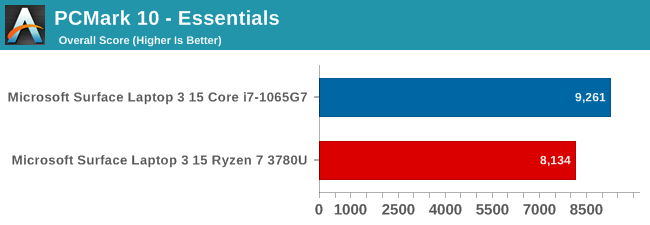

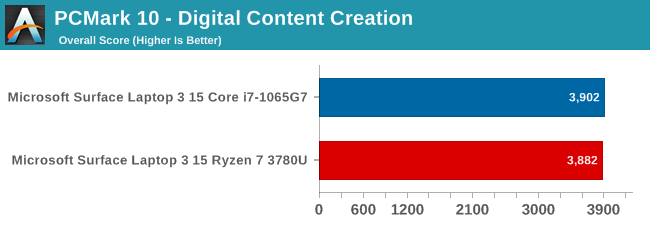
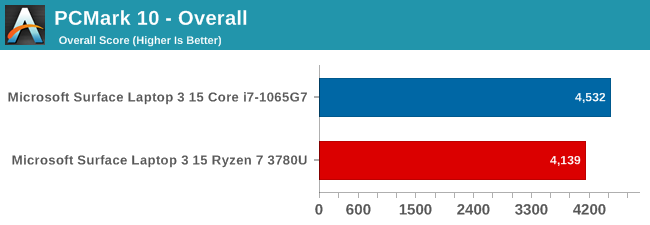
PCMark 10 consists of several real-world tests, including web, video conferencing, spreadsheets, writing, and more. There are several GPU tests as well, including rendering, and some gaming. The suite also measures application start-up, and all aspects of the system’s performance factor into the score.
Intel’s CPU performance lead shows clearly here again, with significant leads in both the Essentials and Productivity tests, although AMD’s strong GPU pulls the Ryzen system very close on the Digital Content Creation tasks. But that is not enough to turn the tide, and the Ice Lake platform carries this win.
Cinebench R20
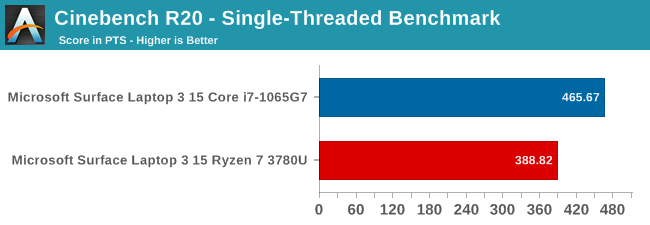
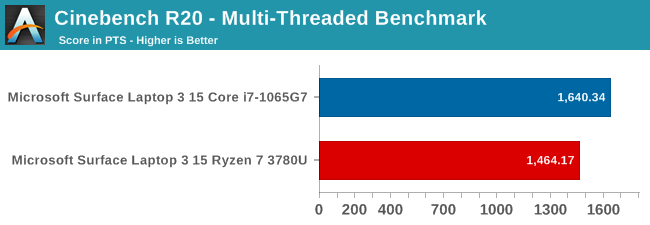
Looking at the latest version of Cinebench tells a similar story as to what we’ve seen so far. Ice Lake’s significant IPC lead pulls it way ahead. On the multi-threaded test, the AMD platform does close the gap somewhat, which is similar to the SPEC rate 8 results.
7-Zip
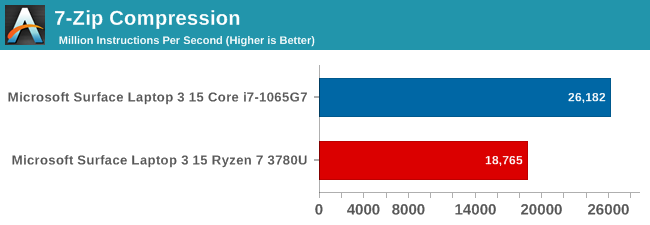
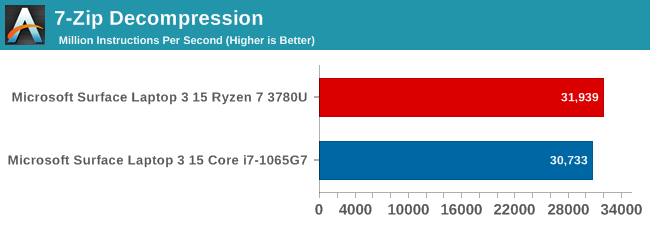
Checking out the popular 7-Zip file compression tool, the results are in-line with what we see in the desktop space. Intel generally has a lead on the compression side, but AMD claws back at decompression. It is a rare win on the CPU side for AMD here.
Handbrake
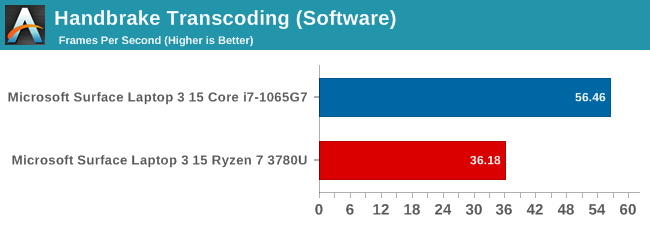
Transcoding is a popular task, and Handbrake is one of the most popular tools. For this test, a 1080p movie is converted to 720p using the x264 encoder. Once again, Ice Lake offers significantly more performance when transcoding in software.

Handbrake also supports various hardware encoders, such as Intel’s QuickSync, which provides significantly quicker transcodes at the same settings – albeit at larger file sizes and slightly lower quality compared to the software transcode, according to the Handbrake documentation. QuickSync has been very popular, and has been around quite a while. AMD also offers hardware encoding and decoding with their Video Core Next platform. Handbrake does support AMD’s Video Coding Engine (VCE) but the Surface Laptop 3 does not offer this as an option in Handbrake, so it was not able to be tested. As this is the only current Ryzen mobile APU we’ve tested, it may be a driver issue specific to the Surface branded processor.
x264
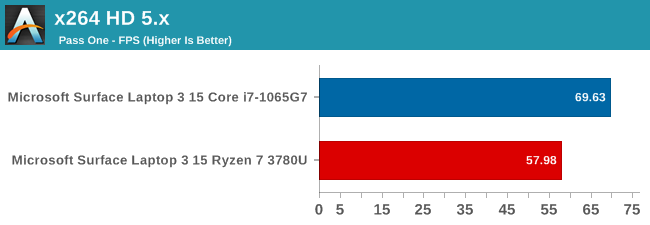
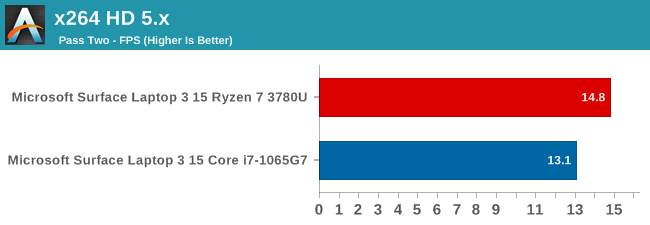
Our previous transcoding test, x264, was also run. Here we see that once again Ice Lake has a significant performance advantage, as it did with Handbrake software encoding.
Web Tests
All of our web tests were run with the current version of Microsoft Edge in Windows 10 1909. Web results are highly impacted by the underlying scripting engine, and Microsoft is going to be moving Edge from the EdgeHTML rendering engine to the Chromium open-source project that powers Google Chrome. When they make this change, expected early in 2020, we’ll revamp our suite with new tests.
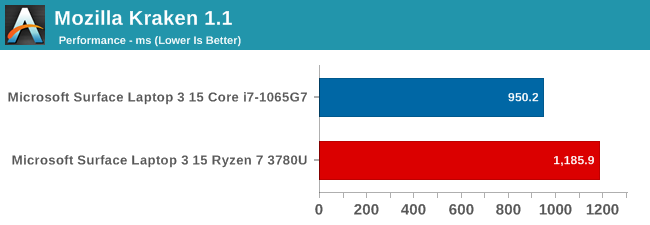

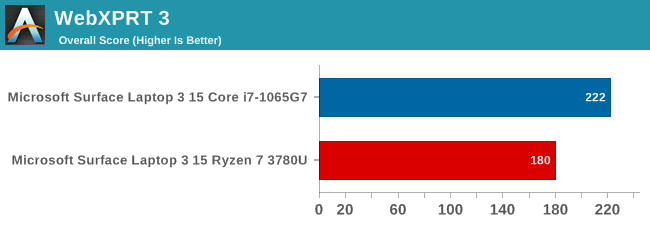
Intel has aggressively pushed their frequency ramping with Speed Shift, and one of the biggest beneficiaries of Speed Shift is web scripting, since the tasks tend to be very short. AMD is addressing this in Zen 2 with Collaborative Power Performance Control 2, or CPPC2, which is not as elegant of a name as Speed Shift, but promises to drop Zen’s frequency ramping from ~30 ms to ~1 to 2 ms, and will be a welcome addition on our web tests.










174 Comments
View All Comments
Korguz - Friday, December 20, 2019 - link
HStewart.. and yet to STILL believe the lies intel tells you.. that is why you are thought of as an intel fanboy... until intel delivers on what they claim, and actually have products out, and no, the limited products on 10nm, that max out at quad core and lower frequencies then 14, does NOT count, anything they say, should be treated as BS...going by your post.. you have NO proof of your claims... and they are in fact, just your opinions...
MBarton - Monday, December 30, 2019 - link
At this point Intel's roadmaps are nothing more than lip service for investors. Absolutely nobody takes them seriously.djayjp - Friday, December 13, 2019 - link
AMD should've led Zen 2 (third gen Ryzen) with mobile first. Oh well maybe next generation.djayjp - Friday, December 13, 2019 - link
Also the marketing name for the chips really doesn't help, in fact I think it works against them and makes them look bad.ChubChub - Sunday, December 15, 2019 - link
Absolutely this. A friend's 6600k just died, and wanted to go with AMD. I'm up to date with most computer stuff, so he asked my opinion.He was thinking a 3400g,because APU + 3rd gen Ryzen. It was weird to tell him that AMD stupidly named the 1st gen APUs with the 2nd gen nomenclature … then continued this stupidity for no reason. All chips 1xxx are Zen, all 2xxx chips are Zen+, all 3xxx chips are ZEN 2 … well, except the APUs, which are all back a generation.
I have high hopes for the 4xxx APUs; would be nice if they fixed the naming by pushing them back to 3xxx. However, even better would be Zen 3 cores in mobile; 4xxx naming would then make sense, they could get some volume out on the 7nm+ process that already works, use ASMedia/VIAs new higher efficiency chipset slated for Zen 3, and they'd likely decidedly obliterate Intel's offerings on CPU and GPU performance (probably not on power though; Intel is doing some good stuff there). One can dream.
MikhailT - Friday, December 13, 2019 - link
I disagree, AMD is winning over a lot of the big businesses with their EPYC chips. They need the cash more than they need laptop revenue at the moment and 7nm capacity is very limited. It's best to start with the highest-profit maker first.Get the business on their side, get more money to grow their team and then they'd be able to do more stuff at the same time like Mobile, Server, Desktop, Gaming, and so on.
All this means is that we can hope to look forward to see what Surface Laptop 4 can do with AMD's Zen 2 chips when it comes out next year.
MBarton - Monday, December 30, 2019 - link
Why? So AMD can delay their most valuable products (Epyc and Threadripper) so they can attempt to make some low margin mobile sales? Ridiculous. Mobile is one area that Intel is still fairly competitive in. There's no reason to give up high margin markets where AMD has a strong advantage, for a market where AMD would be forced to compete head on with Intel 10nm for low margin sales.Fataliity - Friday, December 13, 2019 - link
It is interesting how you did the test. I understand ur playing at "Value" because its a laptop. But if its getting 100FPS why couldn't you turn up the graphics a bit to get around 60, to show what people should expect? Because at "Value" you are purposelly making the 18% IPC affect the FPS in the situation (720p is "CPU Bound" at low)...I also noticed you used alot of "real world" names for your cpu tests, even synthetics. While the gpu synthetics you just called "gpu tests"...
... You put the Ice Lake system in the best possible light is what I"m saying. Gave it every advantage. Why?
Lord of the Bored - Saturday, December 14, 2019 - link
Because it is the thirteenth. They are wildly and insanely obviously in the pocket of Intel on odd days. Come back on an even day if you want an AMD-biased test, because those are the days AMD bought.Brett Howse - Saturday, December 14, 2019 - link
Because we use the data for future articles:https://www.anandtech.com/bench/Notebook/725
If I run at random settings then the data isn't useful for the future.
Also if anything the AMD system was put in the best light because it was running at 1280x720 instead of 1366x768, as mentioned in the article.